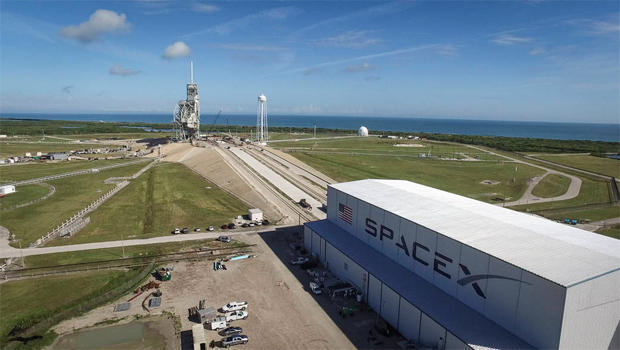Continuing its recovery from a launch pad explosion last September, SpaceX is gearing up for a Falcon 9 engine test firing at a repurposed shuttle pad at the Kennedy Space Center, a critical step toward verifying the booster and extensively modified pad systems are ready for launch Feb. 18.
Multiple sources said the “hot fire” test of the rocket’s nine Merlin 1D first stage engines is on tap Friday, but SpaceX has not announced an official target date and as of midday Thursday, the booster was not yet on the pad.
Whenever they occur, the test firing and eventual launch will mark the first operational use of pad 39A since July 2011 when Atlantis blasted off on the shuttle program’s final flight and the first Florida launch for SpaceX since a Falcon 9 exploded just before a similar pre-flight hot fire test Sept. 1 on nearby pad 40 at the Cape Canaveral Air Force Station.
The spectacular mishap knocked pad 40 out of action, but SpaceX already was modifying pad 39A, just 3.6 miles away, to support Falcon 9 launches and flights by a more powerful heavy-lift version of the rocket.
Since the accident five months ago, engineers have been working around the clock to complete extensive modifications to the historic pad where huge Saturn 5s once boosted Apollo astronauts to the moon and where the shuttle Columbia took off on the program’s first flight in 1981.
A large rocket-processing hangar at the base of the elevated pad now blocks the old river-rock roadway where massive crawlers once carried Saturn rockets and space shuttles. Falcon 9s will be carried from the hangar, which can house five rockets at a time, to the top of the pad horizontally by a transporter-erector and then raised vertical using a powerful hydraulic system.
Propellant lines leading to liquid oxygen and kerosene fuel tanks are in place along with a revamped water deluge system to cool pad structures during launch and to deaden the acoustic shock of engine ignition. Data and power lines have been installed and the old flame trench bisecting the pad to carry exhaust away has been partially filled in with hydraulic and other systems.
SpaceX is slowly dismantling the old payload changeout room that used to swing into place around space shuttles before launch but will keep the central fixed service structure gantry. A crew access swing arm will be installed later for use by astronauts boarding SpaceX commercial crew capsules for flights to the International Space Station.
“This is a huge pad,” Hans Koenigsmann, vice president of flight reliability for SpaceX, told reporters Wednesday. “The transporter-erector is huge. It’s like one-and-a-half million pounds of steel (and controls) all the interfaces (with the rocket). ... This whole thing was a huge effort, and at the end of it you want to test and test things again to make sure they’re ready to go.”
SpaceX chalked up a successful return to flight last month with a launch from Vandenberg Air Force Base, Calif., and hopes to make it two in a row with its inaugural launch from pad 39A at 10:01 a.m. EST (GMT-5) on Feb. 18. If all goes well, the rocket’s first stage will fly itself back to a landing at the Cape Canaveral Air Force Station for possible refurbishment and eventual use on another mission.
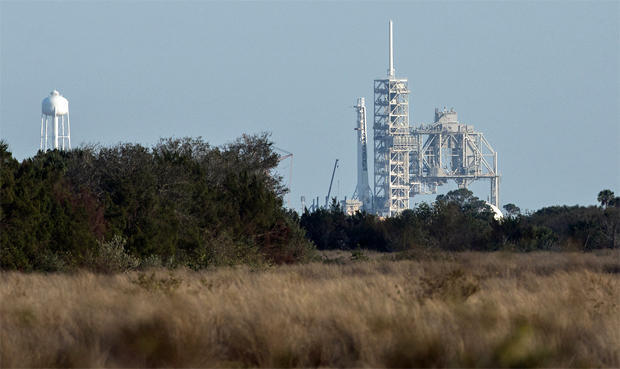
In this view of pad 39A, the SpaceX transporter/erector can be seen just to the left of the large central gantry.
Over the past week or so, the transporter-erector has been seen at the top of the pad going through repeated tests but overnight Tuesday, it was lowered and rolled back to the processing hangar. Exactly when it might reappear carrying a Falcon 9 rocket is not yet known.
All Falcon 9s undergo fueling and a short first stage engine test firing before each flight to make sure all ground and flight systems are operating properly before pressing ahead with launch a few days later.
Five minutes before a planned hot fire Sept. 1, the second stage of a Falcon 9 rocket carrying a communications satellite suddenly exploded in a churning fireball. The rocket and the $200 million satellite were destroyed in the conflagration and the pad suffered unspecified damage. SpaceX hopes to complete repairs and return it to operation by mid May.
Engineers investigating the disaster were unable to find a definitive root cause. But they believe the most likely explanation is the rupture of a high-pressure helium tank inside the rocket’s second stage liquid oxygen tank. Helium is used to pressurize the propellants, pushing them into the engines during flight.
SpaceX uses colder-than-normal “densified” liquid oxygen and RP-1 kerosene rocket fuel to enable the boosters to carry more propellant, increasing performance. Engineers believe liquid oxygen worked its way into gaps between a helium tank’s carbon overwrap and its aluminum skin, possibly solidifying and triggering the tank’s catastrophic rupture.
SpaceX has modified the fuel-loading sequence to prevent the sort of ultra-low temperatures that could lead to solidification. The revised procedures were used during SpaceX’s successful return-to-flight last month at Vandenberg.
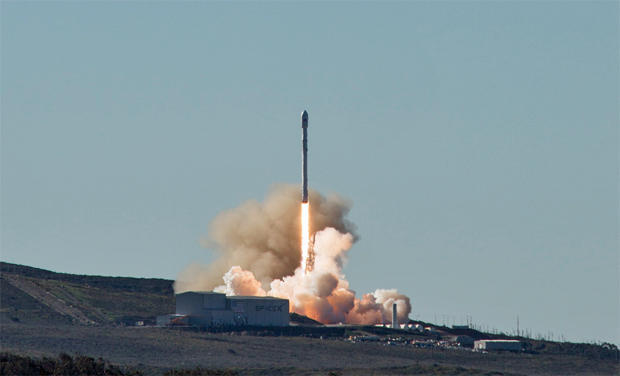
A SpaceX Falcon 9 climbs away from Vandenberg Air Force Base, Calif., Jan. 14 in the company’s first flight since an on-pad explosion in Cape Canaveral last September. SpaceX hopes to chalk up a second straight success this month with launch of a Falcon 9 from complex 39A at the Kennedy Space Center.
SpaceX originally planned to make its first use of pad 39A with launch of an EchoStar communications satellite in late January, followed by the space station resupply mission this month. The station flight, known as CRS-10, originally was planned for last October but it was delayed following the Sept. 1 launch pad mishap.
Completing the modifications at complex 39A delayed the EchoStar launch campaign and NASA sources said the agency asked SpaceX to keep the station resupply flight on track for launch this month. As a result, the EchoStar launch was moved to around March 1.
The Dragon cargo ship that will be boosted into space atop the Falcon 9 will carry more than 5,200 pounds of supplies and equipment to the station, including an ozone monitoring experiment, 580 pounds of crew supplies, 842 pounds of spare parts and other vehicle hardware and more than 1,600 pounds of science gear.
Also on board: 20 mice that will be returned to Earth aboard the Dragon as the end of its mission to help researchers learn more about what processes prevent most vertebrates from regrowing lost limbs or tissue.
NASA hopes to follow the SpaceX/Dragon mission by launch of an Orbital ATK Cygnus cargo ship atop a United Launch Alliance Atlas 5 rocket around March 19. SpaceX plans to follow the CRS-10 flight by launching the EchoStar satellite and then an SES communications relay station shorty thereafter.
The SES fight will be the first using a previously flown Falcon 9 first stage, one that was launched last year and recovered after a pinpoint landing on an off-shore drone ship. SpaceX hopes to lower launch costs by routinely recovering, refurbishing and re-flying booster stages.
Quelle: CBS News
-
Update: 11.02.2017
.
Fire to return to LC-39A with Falcon 9 static fire ahead of CRS-10 launch

A moment nearly six years in the making. Fire and flame are expected to return to the historic LC-39A launch pad at the Kennedy Space Center as SpaceX conducts the static fire of its Falcon 9 rocket tasked with lofting the SpX-10 Dragon resupply mission to the International Space Station. The ignition – now scheduled for Saturday – of the Falcon 9’s engines will be the first time since the Space Shuttle Atlantis left Kennedy on 8 July 2011 that the sound and thrust of rocket engines have graced pad 39A.
The path to static fire:
LC-39A was already deep into its reconfiguration – more accurately described as a complete rebuild – for the Falcon rocket family at the time of the AMOS-6 static fire mishap on 1 September 2016.
At the time of AMOS-6, Pad A was nowhere near the top of the priority list for SpaceX, which was marching through – at a quick cadence – its 2016 launch manifest with SLC-40 at the Cape Canaveral Air Force Station.
At the time of the mishap, SpaceX had hoped to have LC-39A at the Kennedy Space Center (KSC) “ready” to host its first Falcon mission by November 2016.
Once the AMOS-6 accident occurred, the readiness of 39A quickly catapulted to the top of the priority list for SpaceX as the company completed its investigation into the static fire RUD (Rapid Unscheduled Disassembly) and successfully returned the Falcon 9 to flight with the Iridium NEXT mission in January 2017 from Vandenberg Air Force Base in California.
While LC-39A – from the Shuttle era – contained elements SpaceX could use, such as a flame trench, a launch pad, and a sound suppression system, extensive modifications to the pad had to be made to accommodate the Falcon 9 and Falcon Heavy rockets.
Perhaps the most visible of these changes involved the construction of the Horizontal Integration Facility (HIF) on top of the former crawlerway inside the pad perimeter gate as well as the installation of rainbirds to douse the pad and rockets with sound suppression water.
Additionally, electrical connections, data cables, propellant feed lines, and a host of other reconstructive efforts had to be undertaken at the pad to accommodate the Falcon rocket family.

In essence, SpaceX was constructing an entire new pad at KSC – with the physical, aboveground features of 39A remaining largely as they were at the completion of the Shuttle program – with the Fixed Service Structure (FSS) and portions of the Rotating Service Structure (RSS) still standing.
Moreover, a unique element that has drawn attention to Pad A’s readiness to host a Falcon rocket is that the pad itself is the critical item in determining when the first Falcon flight from 39A can occur.
Normally, delays in development and construction of a rocket outpace the delays to pad construction, verification, and validation.
In this case, the use of LC-39A and the delays to its readiness were thrust into the spotlight after AMOS-6.

Nonetheless, the SpaceX team is to be commended for the superb and time-consuming work they have undertaken at the pad.
In the last two weeks, highly visible progress toward pad readiness has occurred – following the pad’s earlier “completion and activation” for verification and validation testing.
In late January, the Transport/Erector/Launcher (TEL) went vertical at the pad for the first time – testing connections and the new “throwback” release feature (which sounds more dramatic than it will be in reality) that will debut on SpX-10 in which the TEL will retract at T0 instead of earlier in the count as it has on all other Falcon 9 launches.
With those tests complete, SpaceX continued to tweak and refine the pad and TEL.

By 5 February, workers and engineers were into final documentation and validation of Pad A – an internal review process to confirm that the pad is indeed rocket ready.
At the same time, the first and second stages of the Falcon 9 were mated together in the HIF by the night of 6 February, with the TEL moving into the HIF on the 8th for mating to the Falcon 9.
On 7 February, SpaceX formally amended their request to the Eastern Range for the date of the static fire, moving it from Wednesday the 8th to Thursday the 9th within a window of 1600 EST – 2200 EST.
Curiously, SpaceX also requested a backup opportunity for Friday the 10th during the same 1600 – 2200 EST time window. That was since extended to a window that runs through to midnight local time.
However, the attempt was then moved to Saturday for unknown reasons, with the window opening at 1000 EST. SpaceX engineers still used Friday to rotate the vehicle to the vertical position, to allow for final checks ahead of Saturday’s fueling.
The reason for the flow milestones most likely stemmed from the fact that once the Falcon 9 is mated to the TEL in the HIF, it then has to be transported up the ramp of 39A, positioned to vertical, and connected to the pad – at which point a whole new series of tests that can only be performed once a Falcon is on the pad can begin.

As with any new launch pad, identification and fixes of anomalies are to be expected.
Moreover, a security notice to all KSC personnel announced that security would set up roadblocks to the LC-39A and 39B area.
This followed the expected and previously announced closure of Pad B for the static fires and launches of the Falcon 9 from Pad A.
The initial notice stated that Pad B would be closed all day for static fires and closed during the launch periods for all Falcon 9 missions from LC-39A.

A subsequent release noted the exact reasons why 39B would be closed for the events.
According to a document acquired by NASASpaceflight.com and available for download on L2, pad 39B lies within the 2-mile radius around 39A that is the “contamination control buffer around the payload once it arrives in the LC-39A area.”
While this alone would not be enough to close Pad B for static fires, the only roadway accessing Pad B lies right at the edge of the 5,100 foot radius around LC-39A that is the “SpaceX keep out zone” for the static fire as coordinated by SpaceX and the Federal Aviation Administration.
For reference, the same document reveals that the Blast Danger Area (BDA) for the static fire is a 2,700 foot radius around Pad A – which does not come close to Pad B.

The document, while only encompassing the static fire, did lend some explanation for why Playalinda Beach, located north of LC-39A, was to be open to the public for the static fires and launches of Falcon 9’s from Pad A – though that was changed Thursday, and the beach will now be closed for both events.
For every Space Shuttle launch, Playalinda Beach was a restricted area as it lay within the BDA for the Shuttle; however, since Falcon 9 has a much smaller BDA, the beach was originally to have remained open for Falcon 9 launch viewings. A subsequent risk assessment determined that closing the beach was the better option.
Moreover, the document confirms that the KSC Emergency Operations Center will be active and will monitor the static fires of Falcon 9s from Pad A.

The document states that “in the unlikely event of an anomaly, [the KSC Emergency Operations Center] will assist in the response and communicate any necessary actions to the appropriate personnel; even if there were a catastrophic anomaly LC-39A, it would pose no danger or threat to personnel.”
For the SpX-10 static fire, once the Falcon 9 is vertical on Pad A and its electrical, data, and propellant connections are secured and tested, the vehicle will perform a standard countdown with the SpaceX launch team to verify all of the connections and propellant flow capabilities for the new pad.
The countdown test will culminate with a 3.5 second firing of all nine Merlin 1D engines at the base of the Falcon 9 first stage.
Once engine firing occurs, the teams will move into post-fire securing operations, safing the vehicle before de-tanking it and rolling it back to the HIF for payload mate.
SpX-10 launch date moved to Feb. 18 due to range conflict:
At the beginning of the week, SpaceX and NASA had been targeting a launch date of 14 February during an 1131-1136 EST window for the CRS-10 mission to the International Space Station.

However, that date subsequently moved to a new official target date of 18 February due to a range conflict.
The conflict, curiously, was not with the ability of the Falcon 9 to launch but rather with the ability of the first stage to return to Landing Zone 1 (LZ-1) back at the Cape.
While the precise nature of the conflict is not known, it is understood that a portion of the range asset necessary for the Falcon 9 first stage’s return was already spoken for by another customer during the period of the 14-17 February.
In coordination with NASA, SpaceX slipped the launch to the 18th to ensure that the first stage could indeed return to the Cape.
An historic pad marks KSC transition to a multi-user spaceport:
Flames last touched LC-39A on 8 July 2011 during the final flight of the Space Shuttle Program.

After that, Pad A lay dormant, with its immediate future clouded in uncertainty as NASA searched for commercial companies who might wish to take possession of the pad – which NASA had deemed largely unnecessary for the Space Launch System program less the use of its LH2 storage facility for the massive BEO (Beyond Earth Orbit) rocket’s hydrogen fuel supply.
This uncertainty persisted for three years until the formal signing of documents that triggered the beginning of a 20-year lease of pad 39A and its facilities to SpaceX on 14 April 2014.
With all eyes now on SpX-10 and the first SpaceX flight from 39A, the pad is also set to host in 2018 the historic first launch of humans aboard commercial rockets as well as the first human-rated spacecraft to Mars.

With this, SpaceX will add to the impressive career of 39A that stretches back to 1962.
In May 1961, when President Kennedy announced the goal of “landing a man on the moon and returning him safely to Earth” before the end of the decade, it quickly became evident that the existing pads at the Cape Canaveral Air Force Station would not be sufficient for the mighty Saturn V rocket.
In 1962, NASA entered into agreements to acquire 218 square miles of land upon which the Launch Operations Center, subsequently renamed the Kennedy Space Center following President Kennedy’s assassination, was constructed.
Originally, the plan for KSC called for three launch pads, with the launch complex itself officially named Launch Complex 39 and its pads receiving alphanumeric designations of “A” to “C” – with 39A being the northernmost pad and 39C being the southernmost.

As less funding than expected materialized, plans for the original 39A were scrapped, and NASA pursued a two pad system that reorganized the pad numbering system.
Thus, the southernmost pad – which entered its construction phase first – became pad 39A instead of 39C.
Construction workers completed Pad 39A in 1965 and final outfitting proceeded into 1967.
On 26 August 1967, Pad A received its first rocket – the Apollo 4 Saturn V.
With the launch of Apollo 4 came the first of 92 launches from Pad A to date – 12 for Apollo and 80 for Shuttle.
Through those 92 missions, none was as historic as the pad’s use on 16 July 1969 to launch Neil Armstrong, Buzz Aldrin, and Michael Collins on Apollo 11 for the first human lunar landing.
Following the launch of all the crewed Apollo lunar landing missions, Pad A then hosted the launch of the U.S.’s first space station, Skylab, on 14 May 1973.
With the launch of Skylab (the last un-crewed launch to occur from Pad A), the pad was deactivated and formal preparations to transform it into a standing structure model for the Space Shuttle began.
In 1979, 39A hosted its first Space Shuttle stack as the Shuttle Enterprisearrived for fit checks and validation and verification efforts that could only be achieved with a Shuttle at the pad.
The use of Enterprise for these checks made Pad A the only pad to host all six Shuttle Orbiters.
The Space Shuttle era then began from the pad on 12 April 1981 – with Pad A hosting the inaugural flights of Columbia, Challenger, Discovery, and Atlantis.
The pad hosted the first 24 Shuttle missions in exclusivity – from STS-1/Columbia to STS-61C/Columbia.
Pad A also hosted the very first construction flight of the International Space Station (Endeavour’s STS-88 mission in December 1998) as well as the mission which completed U.S. assembly of the Station – Endeavour’s STS-134 mission in May 2011.
Sadly, Pad A’s history includes tragedy, as the pad was the launching point for the Columbia and her crew on 16 January 2003 on STS-107.
Then, as it did at the beginning of the Shuttle program, Pad A hosted the final 18 Shuttle missions in exclusivity – from STS-117/Atlantis to the emotional final flight of STS-135/Atlantis.
Through all of this history, Pad A has been a single user, single spacecraft launch platform.
While SpaceX’s exclusive lease will keep LC-39A as a single user pad, it will now serve two variants of the same rocket family – the Falcon 9 and the Falcon Heavy.
But more importantly, SpaceX’s lease of the pad and its upcoming inaugural launch for a commercial company officially makes the Kennedy Space Center a multi-user spaceport – a prime goal of the facility following the retirement of the shuttle fleet.
Quelle: NS
--
Update: 13.02.2017
.
SpaceX test-fires rocket engines at historic pad
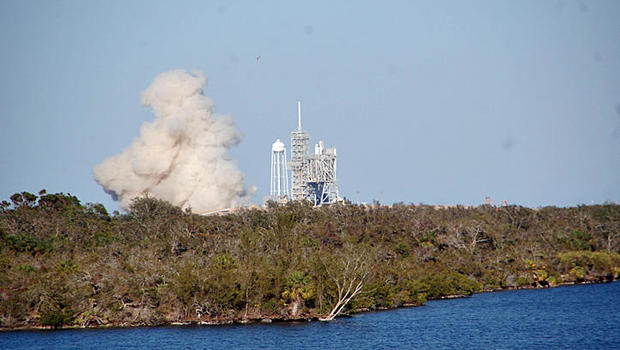
Exhaust erupts from the base of pad 39A at the Kennedy Space Center during a short engine test firing Sunday by a SpaceX Falcon 9 rocket. If all goes well, the rocket will take off Feb. 18 on a space station resupply flight. It will be the first launch off pad 39A since the final shuttle flight in 2011
After working through the weekend, SpaceX test-fired a Falcon 9 rocket’s first-stage engines atop historic pad 39A at the Kennedy Space Center on Sunday, a critical milestone on the road to a Feb. 18 launch of a space station resupply mission.
The Falcon 9 -- mounted on a transporter-erector -- was moved from SpaceX’s processing hangar at the base of the former shuttle pad, up an incline to the top of the firing stand before dawn Friday. The rocket was then erected to the vertical launch position in preparation for the so-called “hot fire” test.
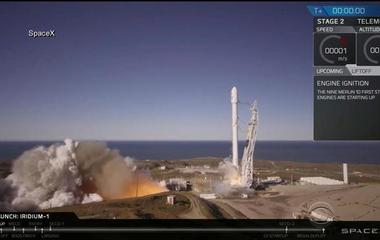
SpaceX celebrates first successful launch after rocket went up in flames
All SpaceX Falcon 9 rockets undergo such static firings before each launch to verify all ground and flight systems are ready for takeoff. In this case, the test also marked a crucial validation of extensive modifications needed to convert the repurposed launch complex for use by SpaceX.
The California rocket builder does not announce hot firings or provide details of pre-launch processing, but the rocket was easily seen on the pad and observers stood by all weekend awaiting signs of fueling and engine ignition.
Finally, about 4:10 p.m. ET Sunday, white vapor could be seen venting from the booster -- a normal sight during fueling operations -- and a few minutes later, at 4:30 p.m., a billowing cloud of dirty brown exhaust could be seen shooting away from the base of the pad as the rocket’s nine Merlin 1D engines ignited, throttled up and then shut down.
SpaceX confirmed the completion of the test firing in a tweet, saying “First static fire test of Falcon 9 at historic launch complex 39A completed in advance of Dragon’s upcoming mission to the @Space_Station.”
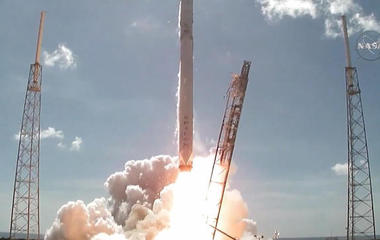
Behind the scenes of SpaceX's groundbreaking work
Assuming telemetry confirms a successful test and no major problems develop, SpaceX hopes to launch a Dragon cargo ship carrying more than 5,200 pounds of supplies and equipment to theInternational Space Stationat 10:01 a.m. on Feb. 18. It will be the first launch from pad 39A since the orbiter Atlantis blasted off on the shuttle program’s final flight in July 2011.
During preparations for a hot-fire test Sept. 1 at the nearby Cape Canaveral Air Force Station, a Falcon 9 exploded in a huge fireball five minutes before engine ignition. The rocket and its $200 million satellite payload were destroyed and launch complex 40 was heavily damaged.
SpaceX ultimately concluded the failure was triggered by the rupture of a high-pressure helium bottle inside the liquid oxygen tank of the rocket’s second stage that was caused in part by ultra-low propellant temperature.
Procedures have since been modified to prevent a repeat of the failure and SpaceX successfully launched a Falcon 9 on Jan. 14 from Vandenberg Air Force Base, California. If all goes well, the company will follow the Falcon 9/Dragon flight with launch of an EchoStar communications satellite around March 1.
Quelle: CBS
-






